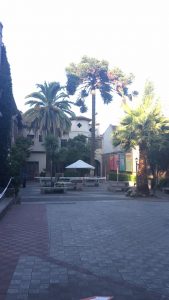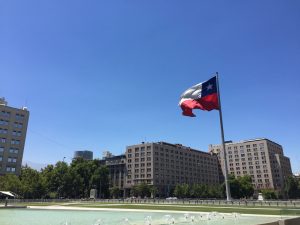Mi Casita Nueva
I have spent three weeks in this new home of mine. Three weeks filled with lots of sunshine (and lots of bloqueador del sol since there is a hole in Chile’s ozone layer), español with more slang than I can keep track of, climbing hills (read: mountains) to get those nice views of Santiago, and a ridiculous amount of bread. While it hasn’t all been easy and smooth, I feel as though I am finally settling into a life here in the Southern hemisphere, and I am truly enamored.

The semester doesn’t actually start until March (it’s summer here right now), but I am taking an intensive Spanish course through Universidad Alberto Hurtado (pictured above), which is technically broken up into three different classes: gramática y poesía, cuento hispanoamericano, and cultura y expresión oral. Basically, we do a lot of grammar, a lot of reading, and a lot of talking for three hours each day. It is challenging, but I am lucky to have really great classmates/friends to learn alongside me. The great part about this being a program through a Jesuit university is that I already have so much in common with mis compañeros. There are six other students with me: four from Saint Louis University, one from Loyola Maryland, and one other from Loyola Chicago (go ‘blers). In the short time that we have known each other, we have done a ridiculous amount of laughing, held heated discussions about social justice issues/politics, and had some true bonding experiences (refer back to my previous comment about climbing hills/mountains). I am truly blessed by these incredible, passionate, and hilarious new friends.
Mi familia Chilena is really wonderful as well. In my cozy little apartment, it is my host mom, my two siblings (one brother and one sister), and me. They are so fun and lively and although I cannot always understand what they are saying, they make a conscious effort to speak slowly and clearly and correct me when I need help. Our apartment is located in a really hip and safe neighborhood and is a short walk to the metro station, which I take to get to school and various parts of the city.
“But Maggie, we don’t care what your family and friends are like, how’s Santiago?????” Great question, dear reader. Santiago is a huuuge city with a population of a little over five million people, meaning it accounts for just under a third of the entire population of Chile. It is considered a very safe city, although theft is wildly common and you have to be incredibly conscious of your personal belongings at all times. The city itself is very developed with a nice mix of old and new architecture and lots of colorful buildings. However, there are also very impoverished and underdeveloped regions, which can be seen while driving in and out of Santiago, as well as from the many hilltop views (like other cities and countries, wealth is not necessarily evenly distributed here). Flanking the metropolitan area are the Andes mountains to the East and the Chilean Coastal Range mountains to the West, views I never plan on getting sick of.

“And what have you been doing when you’re not trying to master the horror that is Chilean Spanish????” Another incredible question. Here’s the answer in an easy-to-follow list format:
Cerro Santa Lucia – a little hill/park in the center of Santiago. Not only is it a beautiful park, but it also has incredible views of the city.
Cerro San Cristobol – a larger hill (984ft above the rest of Santiago) on the north side of the city with a beautiful church at the top, as well as a large statue of the Virgin Mary. It’s unbelievably peaceful and offers great panoramic views. While my friends and I had quite the difficult time hiking up (the straightforward, paved path would have been too easy – always take the road less traveled), the peace and beauty at the top was well worth it (vale la pena, one of my favorite Spanish phrases).
Museums – the Centro Cultural Gabriela Minstral (which had an amazing exhibit about Haitian migration) and a Picasso exhibit at La Moneda (the seat of the President of the Republic of Chile with a cultural center underneath)
A visit to Costanera Center, which just so happens to be the tallest building in South America (980ft). It is six floors of mall, fifty-some floors of largely empty office space. It is also home to Emporio La Rosa, which is apparently one of the 25 best ice cream shops in the entire world (I can attest to this, it’s really good).
A day trip to Isla Negra and one of the casas of Pablo Neruda, the late, great, Nobel Prize-winning Chilean poet. Not only was this a great glimpse into the life of this amazing poet and a huge part of Chilean culture/history, it was also a lovely way to spend a day right along the Pacific Ocean and eat some really good, fresh fish.
So there you have it, a snapshot of my last eleven days. While it’s finally starting to hit me just how long six and a half months is (don’t think I don’t miss you, friends and family, I most certainly do!), I am beyond excited for the adventures and challenges I will face during the remainder of my time here. If the last week and a half is any testament to what the rest will be like, I am surely in for the adventure of a lifetime.
Un besito a todos, ¡chao!